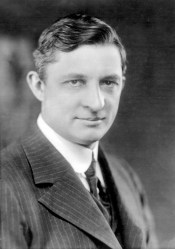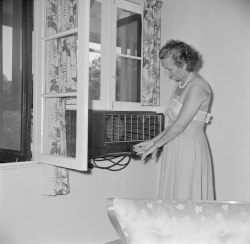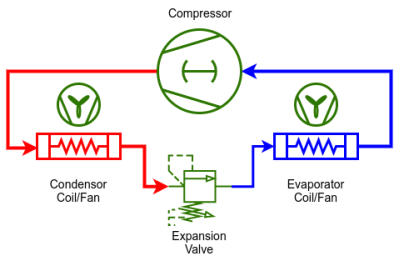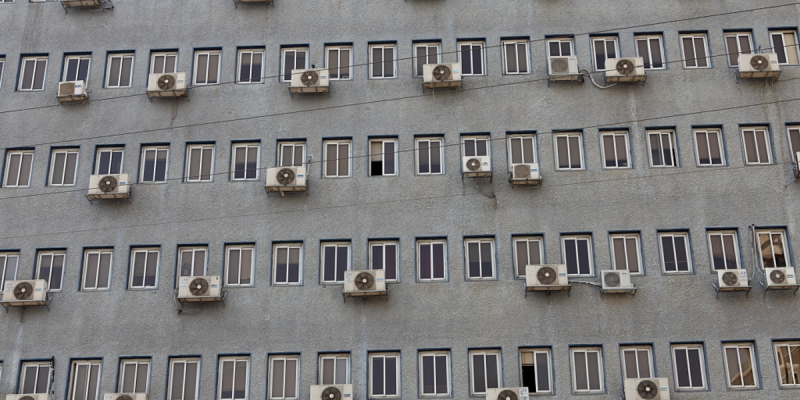I’m always amazed that technology can totally wipe out industries. Sure, some people make a living making horseshoes, for example, but the demand for them is way down compared to what it would have been when horses were the normal mode of transportation. But even so, people still make horseshoes. But think about the ice harvesting business. Never heard of it? Turns out, before refrigeration, there was a huge business of moving ice from where it naturally occurred to other places and storing it, usually underground with a lot of insulation. As far as I know, that business — including the neighborhood ice man — is totally gone now except for some historical exhibitions. We take refrigeration and air conditioning for granted, but it hasn’t been that long ago that ice was a luxury and your own reprieve from the heat was a fan.
Early Cooling
The story starts a little earlier than you might expect. In the 1840s, physician John Gorrie was concerned about “the evils of high temperature.” His hospital in Florida imported ice using the aforementioned ice trade and it wasn’t cheap nor was it very effective.
Undeterred, he developed a machine that used a horse, a waterwheel, steam, or wind power to drive a compressor to create ice. He got a patent in 1851 but it failed to catch on before his financial backer died. In fact, Oliver Evans had the idea in 1805 but never built a working machine. Jacob Perkins patented the first compression cooler in 1834, again with little practical use.
When U.S. President Garfield was shot, Navy engineers built a cooling box using cloths soaked in ice water to cool the president’s hospital room by 20 degrees. Since the mortally wounded president survived 80 days after the shooting, we presume he appreciated the comfort.
Carrier and The Hollywood Connection

We owe modern air conditioning to the magazine printing business. A magazine publisher in Brooklyn had such humidity that their pages were wrinkling. It was not only unsightly but created problems with the printing process. An engineer named Willis Carrier — still a name in the air conditioning business — worked for the Buffalo Forge Company and was asked to solve the problem in 1902.
His invention removed humidity from the air but, as a result, it also cooled down the air. Patents ensued and the apparatus also found use in the textile industry. Eventually, Carrier and six other engineers would leave Buffalo and form a company called Carrier.
It would be the 1920s, though, before the general public started to learn about air conditioning, thanks to the most unlikely venue: movie theaters.
Movie theaters modified their heating systems to blow cold air, which led to patrons on the floor having cold feet and those in the balcony were overly warm. In 1922, Carrier installed a well-designed system at the Metropolitan in Los Angeles. These early systems were prone to failure, however, so later that year Carrier introduced a centrifugal system first used in the Rivoli in New York.
Air conditioning in theaters increased business since people in the heat would gladly spend some money to sit in a cool theater for a few hours no matter what movie might be playing. They might even buy a drink or some popcorn.
At Home
These early air conditioners were big and expensive. They also used flammable refrigerants. Regardless, Frigidaire introduced a two-piece unit aimed at home use in 1929. By 1930, General Electric had an all-in-one design.

This was about the time that General Motors developed chlorofluorocarbons, a nonflammable coolant that would unfortunately later be found to harm the Earth’s ozone layer.
Expensive window units appeared in 1932 but did not become popular. An affordable window unit wouldn’t appear until 1947. Today, in the United States, 85% of homes have air conditioning of some sort. Heating and cooling account for about 48% of U.S. energy consumption.
The Inside Story
So how does it work? When a liquid turns into a gas, it absorbs heat. The trick, then, is to compress a gas into a liquid and then let it turn back into a gas. The compression generates heat, of course, and that is exchanged using fans blowing over the condenser coils.
Ideally, that heat is put out of the area to cool. For a window unit, it goes out the back, for example. This is also one reason why portable units have a hose that you have to hang out of a door or window.

The gas flows through the system to the evaporator coils where it absorbs heat from the surrounding air. Cooling the air also causes condensation and every air conditioner has to dispose of the water somehow. Keep in mind, Carrier’s original device was meant to dehumidify.
An expansion valve separates the high pressure (liquid) side from the low pressure (gas) side. The valve only allows a tiny bit of refrigerant through at one time which prevents the pressure from equalizing on both sides of the valve. The liquid refrigerant suddenly in a lower pressure environment, expands into a gas and that’s what causes cooling.
Of course, there are variations. Fans might be blowers. Some large units cool water which is sent elsewhere, but the principles are the same. Refrigerators are, unsurprisingly, very similar although some of them use a different method to expand the gas and, of course, only cool an enclosed space with little or no outside airflow.
The Future
With air conditioning using so much power, it isn’t hard to imagine that people keep trying to come up with more efficient ways to cool off. Geothermal cooling relies on the fact that underground is relatively cool so you can exchange heat with the Earth making it cooler when your house is warm and warmer when your house is cool. This is a type of heat pump, and some heat pumps are little more than air conditioners that can switch their cold side and hot side via a reversing valve. These heat pumps draw heat from the air, which means when it is very cold outside they don’t work as well as a traditional heater.
Remember President Garfield’s air conditioner? Modern times have made that idea somewhat feasible again. Because of demand, it is often possible to purchase electricity for less cost at low demand times. To take advantage of the lower cost, office buildings can freeze water at night when they are closed and then use that ice to cool the building during the day. This requires a lot of water, of course and is sometimes augmented with traditional air conditioning. When electricity prices rise, maybe ice harvesting like in the video below will make a comeback. Probably not.
Of course, you can always DIY. We’ve seen a guy who builds air conditioners out of whatever he happens to find, or you could build your own small-scale ice cooler.
Banner image “Air Conditioners – Abstract” by zeevveez is licensed with CC BY 2.0.
Thumbnail image “Air Conditioner” by jthetzel is licensed with CC BY 2.0.
















not many farriers actually forge horseshoes these days
most use premade ones, Winchester no longer make guns and ammo but the horseshoe business is in full swing
Speaking (writing) of horseshoes, “winter” horseshoes are available, they have threaded holes in them for “corks”.
Corks work like studs on a tire, originally the corks were hollow for cork to be inserted for better traction.
This link calls the corks “calks”, I’ve never heard it pronounced that way. (maybe in Boston B^)
https://thehorse.com/132567/winter-traction-devices-get-a-grip-before-you-slip/
Hospital in Sundsvall in Sweden uses snow from winter to cool air in summer. https://www.researchgate.net/publication/245063679_The_Sundsvall_hospital_snow_storage
Popular Science had an old article on basically making ice in the winter (because it’s easier) and using that in the summer to air condition.
Storing the winter cold for summer and summer heat for winter is a fairly “trivial” thing and does reduce heating and cooling energy demands rather noticeably.
Even something as simple as just having lots of insulation and a good amount of thermal mass is a fairly good start for thermal storage, indoor temperature will still drift over the year, but most people don’t complain about 1-2 C +/- around normal indoor temperatures of around 20-23 C.
With enough thermal mass one can likely avoid using any heat pumps for cooling and simply rely on the winter months to cool the place down sufficiently to last over summer.
Downside is windows, they tend to let in a lot of IR radiation from the sun, so it is a wise idea to get an IR reflecting coating on the windows to greatly reduce that. (a not all that special thing to be fair. At least where I live it is starting to become common as mud…)
But depending on the area, this is more or less applicable.
> With enough thermal mass one can likely avoid using any heat pumps for cooling and simply rely on the winter months to cool the place down sufficiently to last over summer.
Nice thought, but no.
– To handle the BTU required to meaningfully temper seasonal shifts, the size is limiting.
– A limited size is great for reducing thermal swings over the day, or from a door opening & closing to let someone in or out. As simple as doubled sheets of drywall, or incorporating stone or masonry products within the living space. Pushing that further, some have put sealed tanks of water inside interior walls.
– Used in some solar-heated designs, to capture heat during the day and release it at night. Has to be done right or you can end up being able to bake cookies on surfaces in your living space.
In the tests of super insulated living spaces, the issue becomes the heat generated by people and their activities, from just being there through to cooking.
Where a large thermal mass can be useful, is for a thermal mass reservoir. Using a heat pump, when cooling the living space, the heat energy removed heats the thermal mass. When heating the living space, the heat pump takes heat energy from the thermal mass. The simplest of these is a water tank in the ground. Needs to be sized adequately and insulation reduces losses. First I saw that was in the 60’s, here in Canada. Well, the simplest thermal mass reservoir is the ground in a ground source heat pump. Efficiency benefits are limited and vary on loop size, temperature ranges, water table, etc., but some location setups provide meaningful energy reductions.
In a lot of regions of the world ventilation during the night time hours can provide sufficient cooling even during summer (unless it is a cloudy night.) to keep a modestly sized accommodation cool.
And yes, insulation isn’t magic, and heat generated inside of the space will still increase room temperatures. This is why it is generally advised to have windows that don’t let too much IR through. Since one of the biggest source of heat for most houses is the sun. At a wonderful 1kW/m^2 it is a fairly good space heater. (a human in comparison is comparable to a 60W light bulb, unless the individual is physically active. (ie, more than casually lulling about))
Cooling via the ground is a fairly decent way, since the ground will generally keep the year round average. But one can bias that towards cooler temps by stealing the heat from it during winter, and then through mostly passive means use it for cooling during summer. (the goal is to keep the indoor space comfortable, not cold.)
Though, one can also use the cloud free nights to get a fair bit of heat out into space. If one has sufficient “skill” in thermal management, one can make ice in the middle of summer, anywhere.
But a realistic accommodation in warmer climates is likely to need some degree of heat pumps to help along.
But yes
https://www.nrcan.gc.ca/energy/publications/sciences-technology/buildings/17864
I agree that the amount of mass needed for seasonal temperature stability is enormous. Even Sundsvall’s use of ice is more about melting (a phase change) than about thermal mass of the stored ice.
Phase-changing materials (PCMs) like ice and paraffin wax are great for providing very dense thermal mass. A material that “melts” at the right temperature can keep a house’s internal temperature level throughout a day while outside daily temperatures fluctuate between too hot and too cold. The key is to cool the mass during the night using ambient air so it starts the day in the low-energy state where it can absorb heat throughout the day.
I like to think of it as a heat battery. Where batteries store electrical charge through a chemical change, PCMs store heat through a material phase change.
See https://duckduckgo.com/?q=“phase+change+material”+building
Thanks for this link! Very interesting paper! :)
I live in a 143 flat condonium house in middle of Sweden.
Our heat distribution is water carried to the flats.
We have moved over to a heath pump based system combining 2 sources of heath, one source is the heath exchangers on the ventilation exhausts as a complement to the 16 bore holes of nearly 3000 meters in to bedrock with groundwater at 12 degrees Celsius.
During summer we do a bit of “recharging” the bore holes by circulating the primary circuit heath from the ventilation down to the bore holes at only the cost of the pump electricity.
This to reduce the risk of cooling down our bed rock in the coming 50 years.
This covers our normal heating needs, but we are of course consuming electricity, to be nature friendly we are part owners in a remote wind power farm.
So far we have no central cooling.
Before now the summer heat has not been an issue.
So these pumps supply Heath bars to every flat?
Yummy!
One of the “Little House” books (Farmer Boy) describes ice harvesting and storage in upstate New York. Ice blocks were stacked in an ice house with sawdust between them for insulation and to keep them from freezing together. The ice would keep even in summer temperatures.
IIRC, my grandpa’s estate had a horse drawn ice cutter. No idea what happened to it.
Horses union said neh to that idea.
B^)
And by 1950s, the local ice house was an abandoned structure where the high school kids would hang out.
(and cut to ice house scene in “Bye Bye Birdie”.)
In large parts of Europe quite few people have home AC and those who do have only inefficient and noise portable AC units with a single exhaust hose that lead hot air outside through a partially opened window. Setting up a split unit (heat pump) is not allowed in a lot of apartments buildings and window units are uncommon because US style windows are uncommon.
Anyone coming up with even incremental improvements to, or feasible replacement of, portable ACs can make a lot of money on the european market. Fraunhofer do research on electrocaloric heat pumps* but nothing of that kind is on the horizon for the end consumer portable AC market yet.
From a hardware hacker perspective modifications for noise reduction of existing off the shelf portable ACs could help a lot.
* https://www.fraunhofer.de/en/research/lighthouse-projects-fraunhofer-initiatives/fraunhofer-lighthouse-projects/elkawe.html
Just use one of the portable air conditioners that have two hoses going out the windows. They are twice as effective since the one-hose design pulls in hot air through the door.
Those aren’t commonly available. To get one in the UK I have to import a unit from Canada and shipping will likely be expensive. I’d buy one in an instant if I could.
You can modify a single hose portable AC to dual hose. The single hose type taes room air in through the condenser, which heats it, then blows it out through the exhaust hose. That’s wasting air that the thing has cooled.
How to fix that is get some coroplast, foam board, or even cardboard, and build a box that completely covers the condenser intake. Include a hole for the second hose and modify the window insert for the exhaust hose to run the intake hose through. If in a vertical orientation you’ll want the intake hose below the exhaust hose so the intake won’t be pulling in warmer air from the exhaust. In a horizontal orientation with the hoses side by side you’ll want to add angled deflectors so the exhaust air is directed away from the inlet.
The excellent movie “East Of Eden” has both James Dean and a very nifty ice block factory, shows the early history of refrigerated produce. Should be on every bucket list.
“These early air conditioners were big and expensive. They also used flammable refrigerants.”
AIUI, a proper mix of propane and butane make a suitable replacement for R-12.
The Freon cartel poo-pooed the idea, telling people not to attempt using it in their automobiles because of the danger of explosion.
(As if, automobiles didn’t already have a highly flammable liquid/gas under the hood-that was not in a sealed system)
R290 is propane, R600 is butane, and R600a is isobutane. Unfortunately I think we’re going to see a move to R1234yf in the future simply because the aforementioned freon cartel (DuPont) makes money from it even though R290 is more efficient.
There’s a real difference between propane mixed with butane and the risk of explosion under pressure and gasoline. Gasoline must become a vapor to explosively ignite. It’s normally in the liquid form in the car. So it is much safer than compressing those 2 chemicals and having them go off.
Have you seen what a propane explosion does to a house with a faulty gas grill??
There is an ancient system of refrigeration that even the Romans could have used to make ice or cool temples. Basically, it uses a 10M (30′) tall column of water as its compressor. Water flows down the pipe, past a venturi that sucks in gaseous butane. The water falls faster than the butane bubbles can rise, so they are carried to the bottom. The butane gets compressed back into a liquid at the bottom, and is cooled to the water temperature. A tank at the bottom lets the butane liquid float to the top, where a pipe carries it back through a series of tubes in the region to be cooled. The butane absorbs heat, evaporates back into a gas, and goes back in at the top of the water pipe.
Simple; but only practical if you happen to have a handy source of water with a 10M (30′) head, and know where to find a natural gas well to provide the butane.
That sounds like a trompe
Well, the Persians had a good idea too!
https://www.ancient-origins.net/artifacts-ancient-technology/ancient-advanced-technology-021700
Ice production and distribution is alive and well in developing countries, especially in rural areas, where appliances are unaffordable for most people, and there’s no electric grid anyway, or if there is, it’s very expensive to connect to or use.
As a Floridian, for the past 5 years I have encouraged everyone I know to celebrate a new holiday “Willis Havilland Carrier Day” every July 17. Every Floridian is thankful for Air Conditioning, we wouldn’t survive in Florida without it. Express your thanks by celebrating Willis Havilland Carrier Day too.
“Florida Man celebrates Carrier Day by carrying a Carrier!”
B^)
Lived in Florida all my life, never had an AC. Never needed one.
AC’s are a significant cause of the environment getting hotter, the heat energy can’t be destroyed, only moved from inside to the outside, which then makes everyone to crank up their AC more. Vicious circle.
You must be a true Florida native cracker, sir, and I salute you. I also qualify for that, born and raised, but I guess I am not of such hardy stock. I agree completely with your vicious circle, but I must accept my limitations that my quality of life and peak performance are narrowly optimized at 73 deg F and 45% RH, and AC is the best way to meet those criteria for me. I try to fight the circle in other ways. Hurray for Willis Havilland Carrier!
https://youtu.be/OIq0gwI9Yi0
Air coolers are used extensively in Asia like the one in the video above
There are parts of the US where a cooler like this is adequate. They’re called Swamp Coolers or Evaporative Coolers over here. You’ll find them in places like New Mexico and Arizona where the air is generally quite dry. When you have both heat and high humidity, they don’t work as well as a conventional A/C, since the high humidity inhibits evaporation.
Considering the current drought conditions I wonder how long people will continue using them?
Technology Connections did a very good video on AC/heat pumps and examined the usual claim that they aren’t efficient when the outside ambient air is too cool – they’re actually surprisingly efficient even down to very low temperatures.
A surprising amount of people live with the false idea that heat pumps can’t work if it is bellow freezing outside.
In my own experience living in Sweden, a place that gets fairly cold winters. An air sourced heat pump is still a good bit better than a boring old resistor even if it is -20 C outside. But it is a wise idea to have proper insulation, saves a ton of effort when it comes to heating and cooling.
I’m surprised there was no mention of the magtopressor in the article. It has the potential to revolutionize heat pump efficiency.
https://www.magtor.tech/compressor-concept-magtopressor/
I ended taking apart a Mini-Frig in the early 70’s that had a Single Sided version of this as a Freon Compressor. It was an Electrically Driven ‘Slug’, that was coupled to a Linear Compressor. The design evidently has been around a while, just never took off..
I also saw a Natural Gas Powered Refrigeration ‘Double Linear Stirling’ Compressor.. Same sort of Linear Concept, but with a Linear Stirling Heat Engine, Driving a Linear Sterling Heat Refrigerator. Interesting concept.. Guess it never made it out of the Prototype Stage.
Happy Willis Havilland Carrier Day!